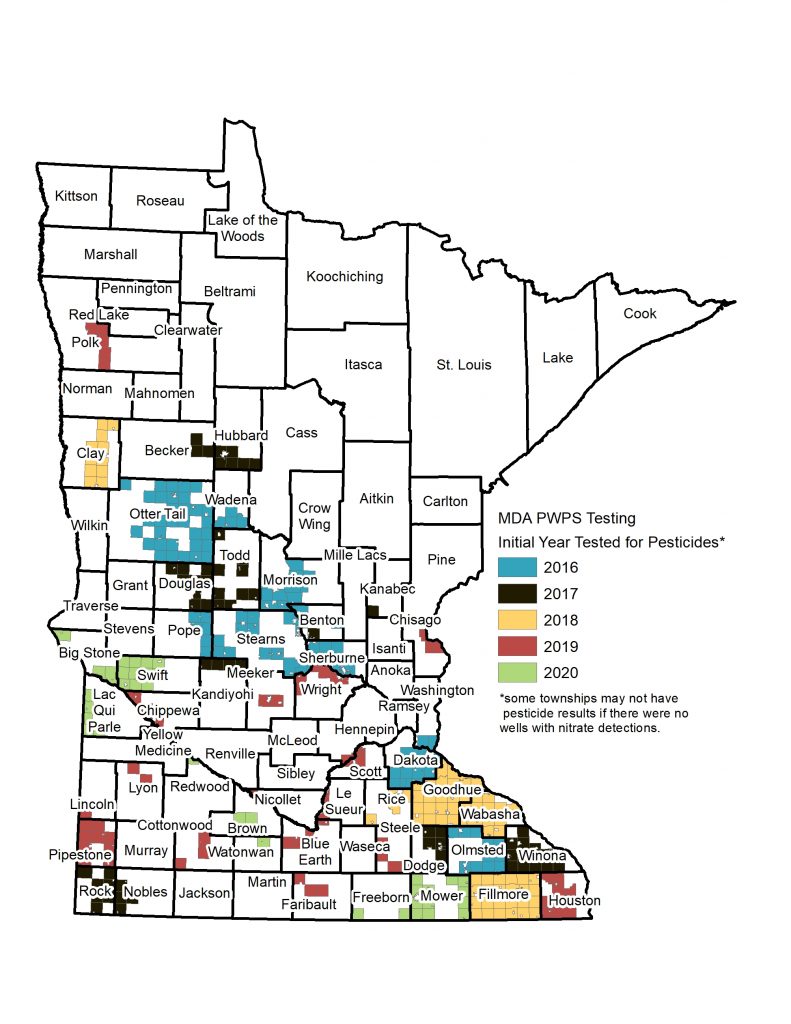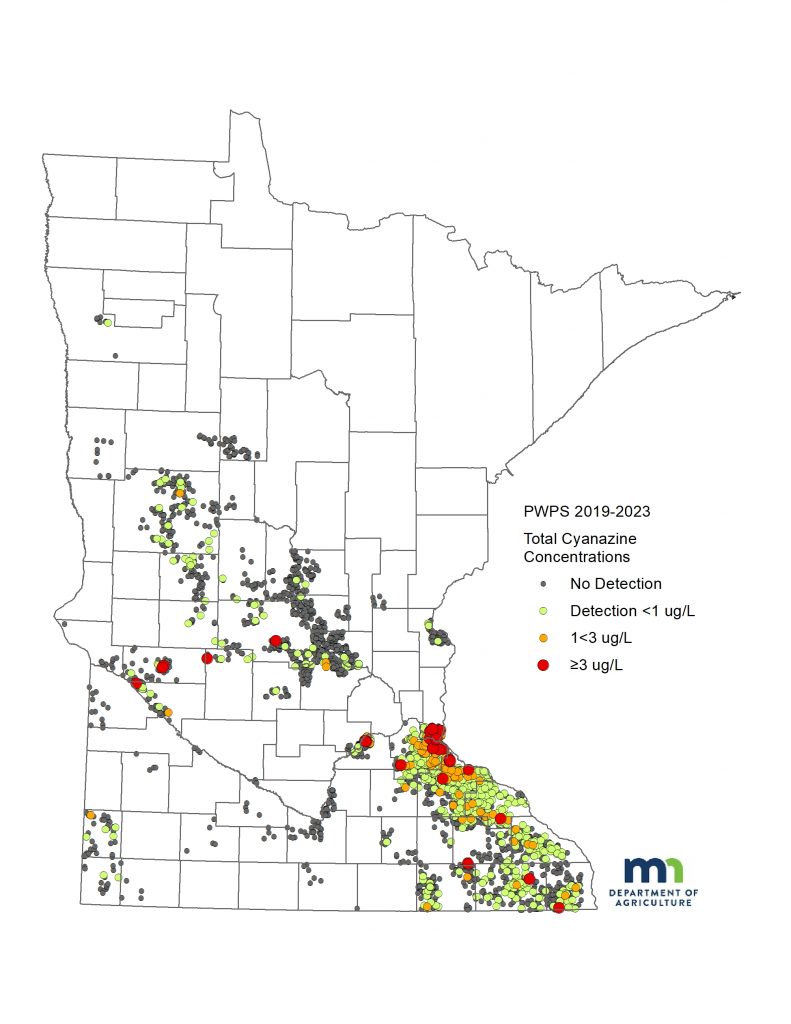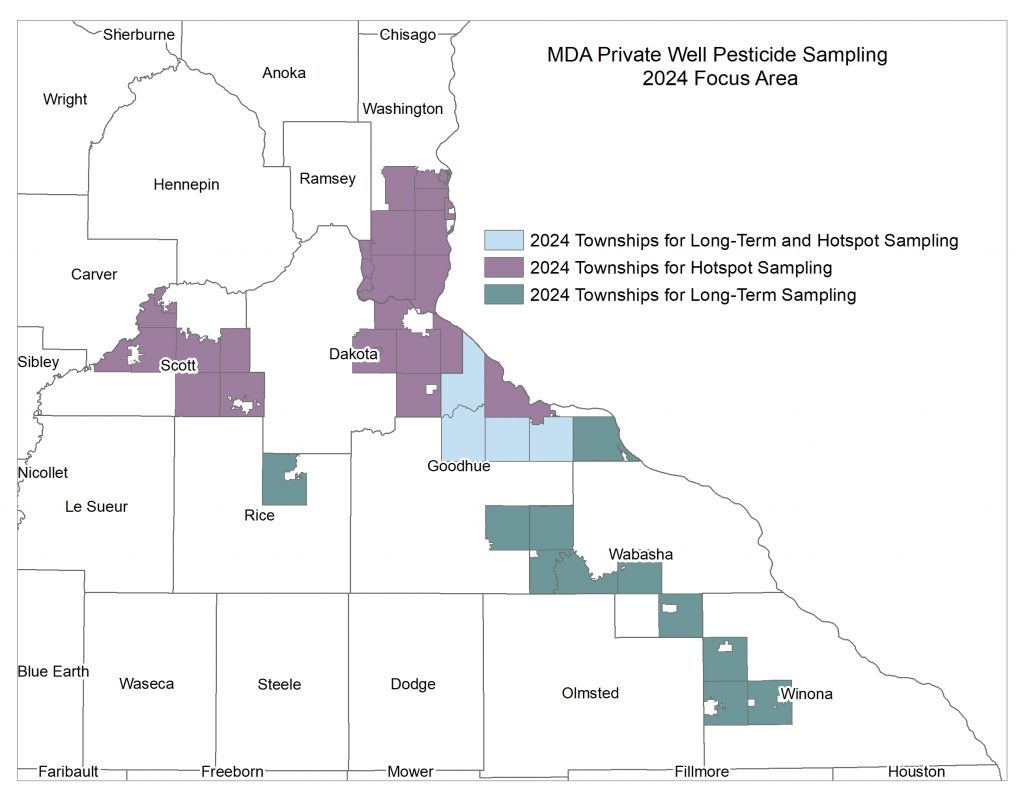by Ben Bruening, Kim Kaiser, Brennon Schaefer and Bill VanRyswyk from the Minnesota Department of Agriculture
In 2014, the Minnesota Department of Agriculture (MDA) began a project that was focused on characterizing pesticide presence in private wells. Using funds provided by the Clean Water Land and Legacy Amendment, the Private Well Pesticide Sampling (PWPS) Project was initially developed as a companion program to the Township Testing Program (TTP), which tested private wells for nitrate-nitrogen (nitrate) in areas of the state with vulnerable groundwater and row crop agriculture. Outreach for the PWPS Project was focused on providing information to well owners and the general public about the presence of pesticides and pesticide break-down products (degradates) in private drinking water wells.

Sampling Strategy
There have been two phases of the PWPS Project. During Phase 1, homeowners that had a nitrate detection as part of the TTP were offered follow-up nitrate and pesticide testing by MDA staff for up to 133 pesticide chemicals. From 2016 through spring 2021, the MDA sampled 5,700 wells in 50 counties for nitrate and pesticides (Figure 1).
Phase 1 Results
Cyanazine was a herbicide that was commonly used on corn in Minnesota, but it has not been registered for use since 2002. Cyanazine and most of its degradates are considered “legacy” contaminants in groundwater. Although the parent compound is rarely detected in groundwater, the combined health risk limit (HRL) is 1 µg/L when the degradates are added together with the parent. This combination of analytes is referred to as “total cyanazine”. The cyanazine degradates were added to PWPS testing in 2019 after testing conducted by Dakota County indicated elevated concentrations in private wells. One of the main conclusions of Phase 1 of the PWPS Project was that the degradates of cyanazine were identified as posing the greatest pesticide-related risk to drinking water in certain areas of Minnesota. Most currently used pesticides rarely exceed existing established groundwater standards. Minnesota is currently the only state evaluating groundwater for the presence of cyanazine degradates.
Phase 2 Methods
The MDA began Phase 2 of the PWPS Project in 2021. Phase 2 focused on characterizing the presence of the pesticides cyanazine and atrazine, and their associated degradates, in areas of the state with vulnerable groundwater. It should be noted that atrazine, which is still used in Minnesota, has two degradates in common with cyanazine.
In Phase 2, several methods were utilized to identify wells that may be at the greatest risk for having an exceedance of the total cyanazine HRL. Past water quality results were assessed from both the MDA and other organizations. In particular, wells were targeted that had elevated nitrate concentrations, as well as the presence of didealkylatrazine and/or deisopropylatrazine, in prior testing. Higher levels or presence of these chemicals were found to have a stronger correlation with higher total cyanazine concentrations. Wells were also targeted on or near past and present agricultural land use areas. Further, wells were targeted in vulnerable geological settings, namely in areas with limited thickness of fine-grained material above St. Peter, Prairie du Chien, or Jordan bedrock. Lastly, wells were targeted near other wells that were found to have had a total cyanazine exceedance previously in testing conducted by the MDA and the Dakota County Environmental Resources Department.
Total Cyanazine Results
From 2019-2023, the MDA collected 3,929 private well pesticide samples across approximately 50 counties in Minnesota (Figure 2). Samples were analyzed for nitrate, as well as atrazine, cyanazine, and their degradates. Total cyanazine was detected in approximately 30% of the targeted wells. During this period, 176 private drinking water wells were identified with total cyanazine concentrations above the health risk limit of 1 µg/L, while 35 were above the acute health risk limit of 3 µ/L. A majority of the total cyanazine exceedances occurred in private wells finished in the Prairie du Chien or Jordan aquifers located in Dakota, Goodhue, Scott, and Washington counties.

2024 Sampling and Mitigation Strategy
In 2024, the MDA has continued to offer testing in Dakota, Goodhue, Scott, and Washington counties. This testing is being offered to better define the local extent and magnitude in areas with known clusters of wells, or “hotspots”, exceeding the total cyanazine HRL. In addition, testing in these counties was expanded to previously untested areas with vulnerable geology and historic agricultural land use. In order to assess changes over time, the MDA also continued to do follow-up “long-term” testing of wells that had a previous total cyanazine exceedance. This is completed on a three-year recurring basis.
Additionally, in 2024, the MDA contracted with Dakota County to coordinate a mitigation program that will provide reverse osmosis (RO) point-of-use treatment systems to well owners previously identified to have an HRL exceedance in Dakota, Scott, and Washington counties. In a similar agreement with Olmsted County, RO systems are being offered to the impacted well owners in eight southeastern counties. Testing conducted by the MDA from wells with point-of-use RO treatment systems over the last several years has indicated a greater than 99% removal of these chemicals (n=92). Funding for pesticide mitigation in private wells is generated from fees paid on pesticide sales in the state.

Next Steps
In 2025, sampling will continue in areas discussed above. The MDA also hopes to add several additional pesticides to the PWPS Project analytical list, including certain neonicotinoid insecticides and fungicides that are of concern in some areas of the state. Mitigation funding will also continue to be offered to well owners with pesticide concentrations at or over the HRLs in their well water.
MGWA is committed to developing a just, equitable, and inclusive groundwater community. Click on the button below to read MGWA’s full diversity statement.